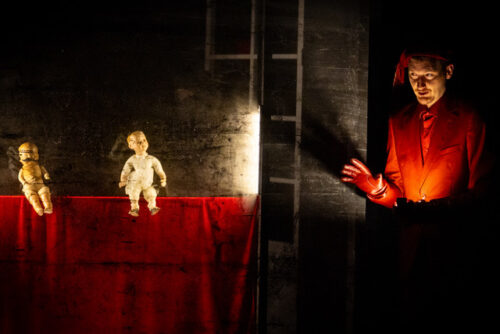 United States Gounod, Faust: Soloists, Band / Jacob Ashworth (conductor). Heartbeat Opera, Baruch Performing Arts Center, New York, 24.5.2025. (RP)
United States Gounod, Faust: Soloists, Band / Jacob Ashworth (conductor). Heartbeat Opera, Baruch Performing Arts Center, New York, 24.5.2025. (RP)

Heartbeat Opera, as its name suggests, gets to the core of a story. For Gounod’s Faust, scenes were cut, dialogue adapted and the score reimagined. The result was a tightly focused tragedy culminating in a transcendent finale – the magical moment that all theatergoers crave. On Broadway, Audra McDonald currently provides this in Gypsy in ‘Rose’s Turn’. For Heartbeat’s Faust, Rachel Kobernick as Marguerite did the same, pleading with God for mercy and the angels to carry her soul to heaven in the opera’s final moments.
Jacob Ashworth and Sara Holdren performed the surgery on Gounod’s opera with imagination and the deftest of touches, interjecting fun into the story while maintaining its serious nature. They achieved the former by crafting the dialogue in English and lacing it with wit. It’s hard to excise the tragedy from Faust, so that was a given. As for the music, Francisco Ladrón de Guevara’s arrangement of the score for chamber ensemble created a soundscape that illuminated the story through an amazing array of colors and textures.
De Guevara didn’t so much jettison Gounod’s orchestration as reimagine it in the image of Méphistophélès. The notes are familiar, but the sounds were timeless and ever shifting, and as beguiling as the devil himself. De Guevara placed the harmonium, also known as the reed or pump organ, as the foundation of his ensemble of ten or so instruments. Once commonplace in homes and churches, the harmonium has a wheezy, reedy sound that can create atmosphere as a solo instrument or anchor the ensemble in simulating symphonic sound. It is not to be found in Gounod’s score, but neither is the mandolin nor the electric bass.
Director Sara Holdren updated the action to the present day. It would have gone unnoticed except for a few costumes, such as the contemporary soldier fatigues worn by Alex DeSocio’s Valentin and Eliza Bonet’s glitzy Martha. The sets were basic, mere outlines of the buildings, but the essentials were there, including Faust’s desk, the window from which Marguerite pines for Faust and a cross atop a church.
Props were pared down to those essential to the story. There was no spinning wheel, but a box of glittering jewels did appear and transfixed Martha as much as Marguerite and the holy medallion. Other requisite details were also realistically presented, such as the bouquet that Siebel leaves for Marguerite and the holy medallion which Valentin believes protected him in battle. Puppetry was used to introduce elements of the plot, such as Marguerite’s pregnancy, as well as to lend the requisite supernatural aura to the devil and his diabolical deeds.
Méphistophélès’s elixir of youth transformed Orson Van Gay II’s professorial Faust into an ardent lover by simply ridding him of his eyeglasses. He expressed his ardor in burnished tones in ‘Salut, demeure chaste et pure’, but he was at his fiery best when inflamed with passion over a frumpy, small-town girl.
As that girl, Rachel Kobernick gave fine accounts of the King of Thule ballad and ‘The Jewel Song’, and matched Van Gay in ardor as he pleaded that she permit him to rescue her from the hangman for killing her unborn child. Nothing, however, prepared one for the power, intensity and glory of her voice in that final scene as she commits herself to God’s mercy.

Tall, pencil thin and lithe, John Taylor Ward’s Méphistophélès was the devil incarnate with his rakish demeanor, gleaming eyes and the smooth beauty of his bass-baritone voice. His sinuous movements stitched the story together as seamlessly as any plot device. His rival in all ways was Alex DeSocio’s Valentin, who dominated the stage with his intense presence and superb voice. Valentin gets one great aria, ‘Avant de quitter ces lieux’, and baritone Alex DeSocio sang it magnificently.
In Ashworth and Holdren’s adaptation, Siebel, the lovesick lad who pines for Marguerite, has greater prominence in the plot than in the full opera. As Siebel, AddieRose Brown did more than toss off a delightful ‘Faites-lui mes aveux’ and recede into the background. She was an integral part of the story, and her earnest demeanor and lovely lyric mezzo-soprano enriched every scene in which she appeared.
Eliza Bonet’s Martha was a blond bombshell with big hair and outrageous blue eyeshadow. It’s a minor role, but Bonet made a meal of it. Brandon Bell’s Wagner was rich-voiced and earnest, and his appearance from the grave was staged particularly well.
Ashworth, who both conducted and played the violin and mandolin, guided the performance with his usual panache. The sounds that he drew from the Band were not ones you would hear in an opera house during a performance of Faust. This is Heartbeat Opera, however, where an operatic classic becomes the springboard for a completely different but singular and equally authentic operatic experience. And, as has become the norm, this Faust was such a hot ticket that additional performances were added to the run.
Rick Perdian
Production:
Director – Sara Holdren
Adaptation – Jacob Ashworth & Sara Holdren
Arrangement for Chamber Ensemble – Francisco Ladrón de Guevara
Sets – Yichen Zhou & Forest Entsminger
Costumes – Elivia Bovenzi Blitz
Lighting – Yichen Zhou
Puppets – Nick Lehane
Props – Corinne Gologursky
Fight director – Rick Sordelet
Sound – Kodi Lynn Milburn
Associate Director – Nico Krell
Cast:
Faust – Orson Van Gay II
Marguerite – Rachel Kobernick
Méphistophélès – John Taylor Ward
Siebel – AddieRose Brown
Valentin – Alex DeSocio
Martha – Eliza Bonet
Wagner – Brandon Bell
Puppeteers – Rowan Magee, Emma Wiseman
Band:
Jacob Ashworth – conductor & violin/mandolin
Yoshi Weinberg – flutes
Louis Arques – clarinets/saxophones
Clyde Daley – trumpet
Artis Wodehouse – harmonium
Ari Livne – piano
Thapelo Masita – cello
Eleonore Oppenheim – bass/electric bass
